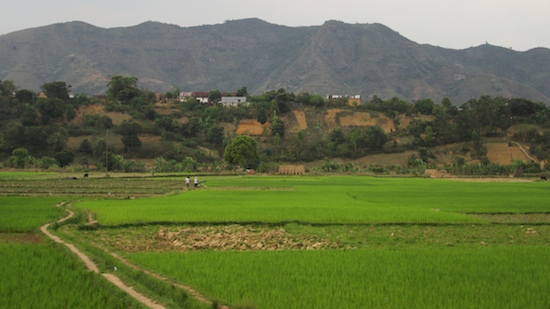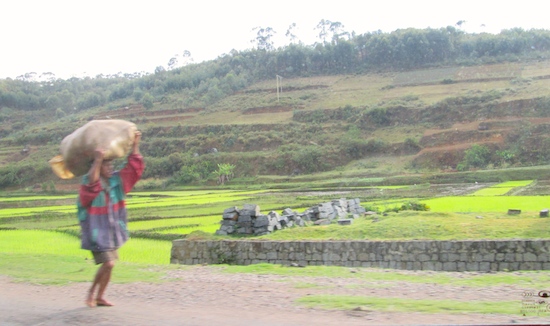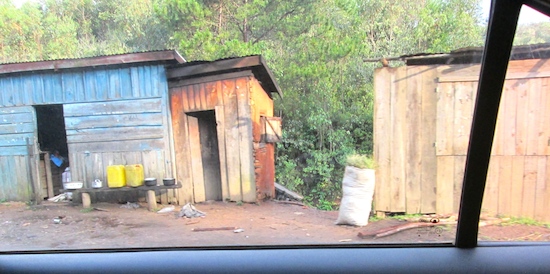It’s a cloudy, drizzly day and we’re on the road to the village of Ampitambe. People are hard at work in the rice fields – bent low and up to their knees in mud. Some take a break in A-frame shelters made of sticks and leaves, building a small fire to warm themselves. I can’t imagine the toll this work takes on their bodies, but I can imagine the snakes that would find such an environment inviting. I confirm this with a man whose family is in the rice business. He tells me that, yes, there are snakes in the fields but assures me they are mostly harmless. When it’s a choice between starvation and braving a few snakes hidden in the muddy waters, there is really no choice.
The overcast day provides a perfect background for the brilliant patchwork of multi-hued greens that make up the rice paddies. A full rainbow suddenly appears in the sky and I wish I could share it with the people in the fields, but they can only see the work to be done.
As we press on, the way becomes narrow, winding, hilly. Huge trucks and motorbikes and bicycles and hand-drawn carts and pedestrians and sometimes, cows, are all competing for their share of the road. Those in vehicles pass each other at high speeds in tight spaces with low visibility on mountain switchbacks. It feels a bit like Mr. Toad’s Wild Ride, but obviously everyone knows how to drive these roads. We turn a sharp corner and happen upon a bad accident involving a truck and what used to be a car. The truck driver appears to be fine, but I can’t see the car passengers. A large crowd of people has gathered; I murmur a prayer as we pass.
It’s a given that these roads are dangerous so I’ll just concentrate on the scenery, which only grows more spectacular the higher we climb. The spiny desert terrain of the Mikea boasts its own haunting beauty with towering baobabs and brilliant night skies, but this is a beauty of another sort – lush and verdant and wild. I wish I could capture it all on camera, but we are moving too fast and bouncing around too much for a point-and-shoot photographer like myself. It’s all a blur.
Soon the rice fields are framed by banana groves. Downward-rushing streams crash and tumble over jagged rocks and the occasional waterfall takes your breath away. Wild flowers of every color crowd the roadside – orange lilies, hanging trumpet vines, buttercups. Thatches of wild roses climb picturesque bamboo fence rails that appear here and there.
We pass a quaint, deserted roadside cafe obviously meant for tourists. The houses of the poor that line the roadway are anything but deserted. Children in drab, ragged clothes kick a fraying ball made of plastic bags held together by tape, their bare feet flying. A little boy with a distended belly throws a rock at a dog with protruding ribs. Everyone is hungry. A bare-footed man scurries, struggling under the weight of a huge sack balanced on his head. An old woman leans on a rickety table next to a pile of blackened bananas and a few papayas. It looks like fruit she picked off the ground. Everyone is trying to make a living.
We pass a town that looks as if it could be in France, if not so ramshackle. Two-story plaster houses painted in Monet pastel shades of blue, yellow and pink sport contrasting wooden shutters and small balconies. Laughing, boisterous school children spill into the street to make their way home, each one dressed the same, each carrying a backpack undoubtedly purchased at an outdoor market stall. Most will study the night away by candlelight or paraffin lamp, as they attempt to block out all the noises in their one-room house.. I notice a young girl staring out of a second story window. She looks to be 13 or 14, but her furrowed brow and worried expression makes her appear older. I wonder why she is not among the students until she hoists a baby onto her hip -a young mother, perhaps, or responsible for her younger siblings while her parents work the fields. Either way, she is not in school.
We climb a steep, winding hill, getting stuck in a traffic jam that involves multiple large trucks and a motorcyclist that flits in and out of the scant spaces between them. Inches from the truck in front of us, I’m thinking of all the times I’ve rolled backwards while driving a stick shift – and decide its better not to think. Eventually the traffic clears, the heavy exhaust fumes dissipate and we enter the town of Moramanga – at rush hour.
This is a traffic jam of a different sort. The streets are a sea of brightly colored bicycle rickshaws, all competing for business and space. The sidewalks are crammed with students returning home and women shopping at tiny market stalls for vegetables, beans, or the sausages that hang on strings in the open air. We pass a police outpost that resembles a large, wooden box; a policeman in a blinding-white shirt leans out the single window, pushing back the blood-red cloth serving as a curtain. He watches the same unfold night after night, leaning out his window, unaware of how striking he looks. One by one the market sellers light their paraffin lamps and candles as we leave the town of Moramanga behind.
We reach Ampitambe after dark and pull into the schoolyard gate. Ibrahim’s sister greets us with a wonderful candlelight dinner of rice and greens, bread and cheese. There will be clean water to bathe in the morning, heated on the outdoor stove and poured, steaming, into a bucket. Everyone retires at 8:00 PM. I’m tired but tonight is a night that calls for less sleep and more prayer. A rooster crows outside my window at 5:00 AM telling me it’s time to greet the day. The schoolchildren will be here soon.





